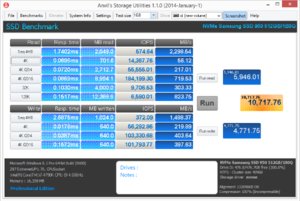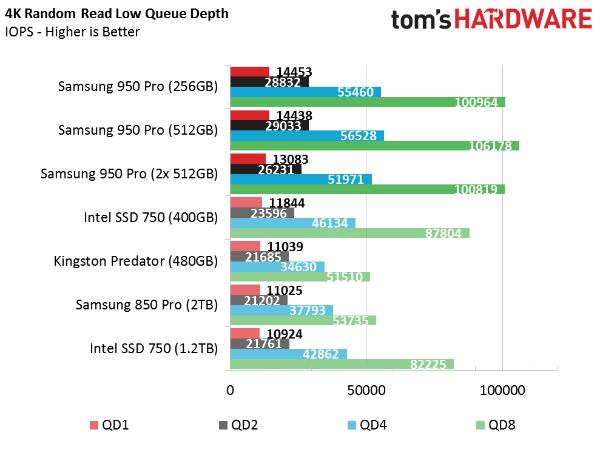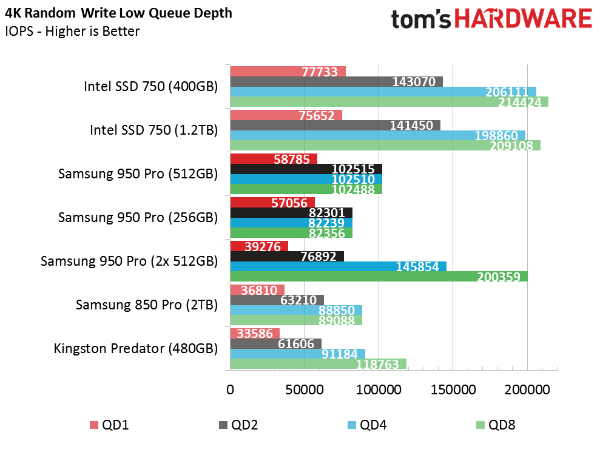Samsung 950 Pro SSD Review
NVMe in the M.2 form factor is finally a reality for desktop enthusiasts. Retailers begin selling Samsung's 950 Pro today, and we already have three drives in-hand.
Why you can trust Tom's Hardware
Initial Performance Results


Entropy (a fancy way of saying the level of incompressible data) does not affect performance on the 950 Pro. That's good news for enthusiasts working with media files, which are typically already compressed.

Samsung's 950 Pro doesn't rely on TurboWrite to burst high levels of write performance. Instead, it delivers consistent sequential and random throughput by virtue of its MLC NAND. In the above screen shot, I wrote 64KB sequential blocks to the drive's full LBA range, observing minimal deviation between the high and low results. TLC-based drives often start out with impressive write speed, and then abruptly give up their strong performance when the emulated SLC cache many of them use fills up.
To read about our storage tests in-depth, please check out How We Test HDDs And SSDs. Four-corner testing is covered on page six.
Sequential Read Performance
As mentioned, we're testing both capacities, along with two 512GB 950 Pros in RAID 0. For comparison, we include Kingston's HyperX Predator 480GB, Intel's SSD 750 400GB and 1.2TB, as well as the latest 2TB 850 Pro.


Right off the bat, Samsung's 950 Pro drives outperform the SSD 750s in sequential reads at low queue depths. Intel's SSD 750s also experience an odd performance drop at a queue depth of two. This may be fixed in the firmware Intel recently released, though we haven't had the chance to re-test with it yet.
Around a queue depth of 16, Intel's 1.2TB model overtakes the 512GB 950 Pro in our sequential read test. But the 400GB SSD 750 never passes Samsung's largest 950 Pro.
The 950 Pros in RAID 0 run away from the rest of the field. That's a result we'd expect in a test moving data sequentially.
Get Tom's Hardware's best news and in-depth reviews, straight to your inbox.
Remember, the 850 Pro 2TB can only be tested up to a queue depth of 32; that's the SATA interface's limit.
Sequential Write Performance


The 512GB 950 Pro and RAID 0 array charge forward with class-leading sequential write performance. And you don't need a taxing workload to realize these results, either. The 950 Pro 256GB falls back in the pack, though its performance is still better than we expected, given the smaller capacity point.
Random Read Performance



From a queue depth of one to 16, Samsung's 950 Pros outperform the other drives we tested. At a queue depth 32 and up, Intel's data center DNA kicks in, giving the SSD 750 an advantage. But in client workloads where low queue depths are involved, the 950 Pro is unrivaled.
If you paid close attention to Samsung's specs, then you already noticed that our random read results fall below the company's claimed 300,000 IOPS. NVMe can queue data a couple of different ways to optimize performance. Samsung's large random read numbers are derived from four workers, each several queues deep. That's a great way to show what NVMe can do. However, until desktop software can emulate that scenario, we'll continue testing under more realistic conditions.
Random Write Performance



Intel's SSD 750 wears the random write performance crown. Two 950 Pros in RAID 0 close the gap, but single-drive random writes go Intel's way. Under a normal load, you won't hit these ceilings (particularly at a queue depth of one). Latency is what's important here, and higher performance at low queue depth translates to low latency results.
Current page: Initial Performance Results
Prev Page A Closer Look Next Page Mixed and Steady State Workload Performance
Chris Ramseyer was a senior contributing editor for Tom's Hardware. He tested and reviewed consumer storage.
-
alidan you need to had a standard hdd to some of these, such as the gaming benchmark, as i want to say most of us dont have money for a ssd game drive, but a 4tb drive that can almost hold every game you own if you install everything, that's more readily available, apposed to the same price for 1/8th the space.Reply -
Larry Litmanen I always wondered why was M.2 designed to lay flat on the motherboard and not sideways like RAM. Wouldn't you save a lot more space on the mobo, plus if it is sideways you can easily find a spot for it on MITX boards.Reply
Also, if i have a modern motherboard (i have MSI Gaming 5, Z97) do i need to go into the BIOS and change something if i want to install this M.2 NVMe SSD.
I know you had to do something on older mobos when installing an SSD. -
Larry Litmanen Replyyou need to had a standard hdd to some of these, such as the gaming benchmark, as i want to say most of us dont have money for a ssd game drive, but a 4tb drive that can almost hold every game you own if you install everything, that's more readily available, apposed to the same price for 1/8th the space.
I game a lot and i have 850 Pro in 256 GB capacity. You don't really need that much space for games if you keep only 2-3 games installed at once. I play one game at a time, when i finish i just uninstall it. What's the point of saving it on PC if i will not play it again ever or at least for a while.
-
jtown80 alidan... no one wants reviews of standard Hard drives. Your behind the times if your still focusing on them and it is pointless to do benchmarks on them.Reply -
CRamseyer Hard drive performance barely even show up on the results when we show throughput performance. The reverse happens in the latency tests, the HDD lines are so long you can hardly see the NVMe performance.Reply -
rgd1101 Can you check the temp and power usage?Reply
Perform much better on the Z170 then on the Z97 reviewed at anandtech.com
Wonder how it perform on an AMD motherboard. -
tom10167 Very cool, I was/am excited for this. However the real world bencmarks say it all. Best case scenario 12 seconds on a 6 minute job is not much and many of those tests were showing half a second difference in performance. Nowhere near good enough for me. Still a nice step but I'll wait for cheaper m2 drives.Reply -
rgd1101 850 PRO EVO is cheaper. Wish they compare both 512GB m.2 and the SATA drive.Reply
Real world peformance probably close. -
arossetti I'm glad this form factor is starting to take off and is reasonably priced. Less cables and power connectors to muck up a build.Reply

